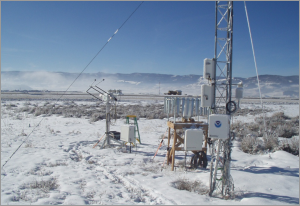
Granby, CO field site
|
|

|

|
Click thumbnail for full graphic | |
|
Contact: Bob Zamora
|
|
HMT Establishes Surface Energy Balance Sites and Upgrades Web Display Tools
The "flux" measurement observatories were developed by researchers at NOAA's Earth System Research Laboratory. The observations will be used to verify land surface model simulations of surface radiation, evaporation/transpiration (ET), and soil moisture. Currently HMT has two flux sites in operation. One site located in Granby, CO and the second near Cazadero, CA. A site survey has been conducted and an additional candidate site has been chosen. The site is located at the University of Auburn Upper Coastal Plain Research Station 50 miles north of the new IWRSS National Water Center in Tuscaloosa, AL. It is anticipated that surface meteorological and soil moisture instrumentation will be installed this year (2012) and will be upgraded to include flux measurements in 2013.
Recent upgrades in the data communication between the flux observatories and HMT data ingest located in Boulder, CO has enabled HMT scientists and engineers to develop web tools that allow near real-time display of the flux data gathered at the locations The data products available for display include soil moisture and temperature at 5, 10, 20, 50, and 100 cm depths, ground heat flux, downwelling and upwelling IR irradiance, upwelling solar irradiance, direct beam solar irradiance, diffuse solar irradiance, turbulent sensible heat flux and turbulent latent heat flux. These measurements make it possible to monitor and evaluate the meteorological and hydrological processes that control the distribution and exchange of water between the soil and the atmosphere.